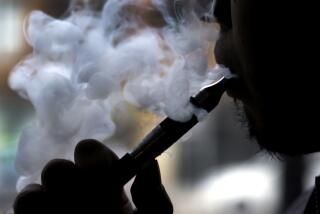RJR Denies Link to Teen Smoking
- Share via
R.J. Reynolds Tobacco Co. doesn’t use its advertising to attract new smokers, let alone children, a company marketing executive testified Monday in Minnesota’s $1.77-billion Medicaid trial against cigarette companies.
Lynn Beasley, RJR executive vice president and architect of the company’s controversial Joe Camel campaign, testified in an attempt to blunt the impact of documents introduced earlier showing that RJR discussed appealing to smokers as young as 14.
“It would be crazy [to appeal to children] because every time a kid lights up, we get blamed,” Beasley said. “That makes it harder for me to market to adults.”
The effort at damage control came as the unit of RJR Nabisco Holdings Corp. and other publicly traded cigarette companies continued their defense in the first-ever trial brought by an attorney general against the industry to recover health-care costs.
Like 39 other states that sued, including three that have settled, Minnesota claims that RJR, Philip Morris Cos. and others violated antitrust laws and defrauded the public about the dangers of smoking.
Some of the most dramatic evidence in the case has concerned ads aimed at the underage market. The number of teen Camel smokers rose dramatically in the period when the Joe Camel ads ran, prompting a pending suit by the Federal Trade Commission as well as widespread criticism in Congress.
The ad campaign was withdrawn last year.
Congress is considering legislation to force the industry to pay as much as $516 billion and submit to much tighter regulation of advertising and other practices.
Beasley said that recruiting new smokers of any age “has never been an objective” at RJR.
She said the Joe Camel campaign was created when a focus group of smokers between the ages of 18 and 24 liked a poster intended for the brand’s 75th birthday campaign.
“They loved it. They said it’s fun, it’s entertaining and you should use it,” she said. Beasley said the company avoided using a punk “new wave” look as well as party favors in order to keep the ads from appealing to underage smokers.
Beasley said advertising and promotions by R.J. Reynolds are designed for people who already smoke in hopes that they will change brands. RJR is the nation’s No. 2 cigarette company, with about a 25% market share.
Beasley said that Reynolds has always used smokers at least 18 years old in its focus groups, which are designed to determine which advertising campaigns are the most effective.
More to Read
Sign up for Essential California
The most important California stories and recommendations in your inbox every morning.
You may occasionally receive promotional content from the Los Angeles Times.













